Workplace Learning Programme: Planning and Assessment in Healthcare
VerifiedAdded on 2023/01/04
|11
|3757
|80
Report
AI Summary
This report provides a detailed analysis of the learning process within a health and social care workplace, specifically focusing on the NHS. It begins by explaining various ways learning can occur, referencing Kolb's Learning Cycle and highlighting the importance of communication, training, and development. The report then describes key factors to consider when planning a workplace learning program, such as team organization, scheduling, theoretical experience, and learning styles. Furthermore, it presents relevant teaching strategies like classroom-based teaching, demonstration, and independent learning for supporting the learning of others. The document also suggests strategies for delivering and assessing learning, including the Six Sigma method. Finally, it addresses potential barriers to learning, methods for identifying learning needs, and strategies for supporting individual learning needs within the health and social care workplace.
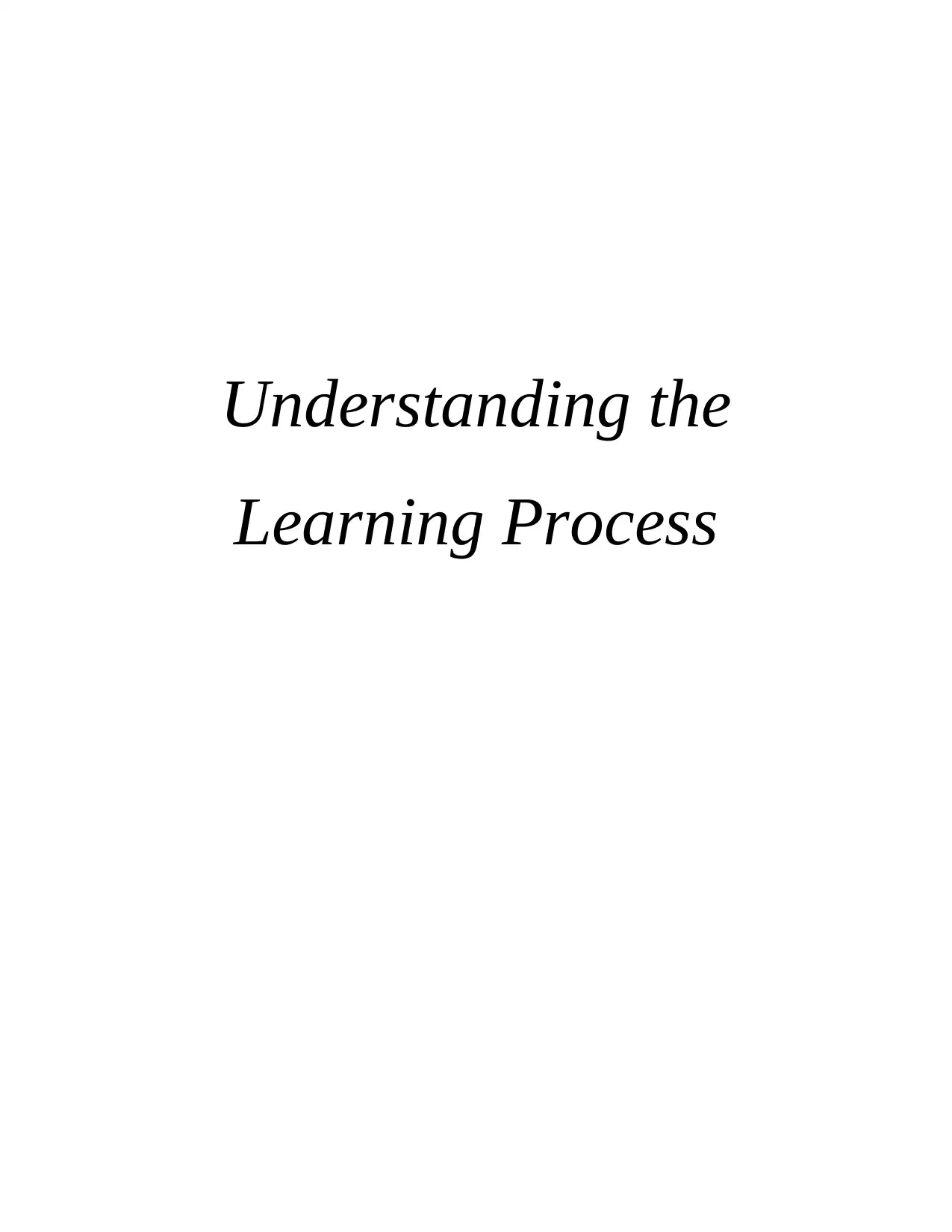
Understanding the
Learning Process
Learning Process
Paraphrase This Document
Need a fresh take? Get an instant paraphrase of this document with our AI Paraphraser
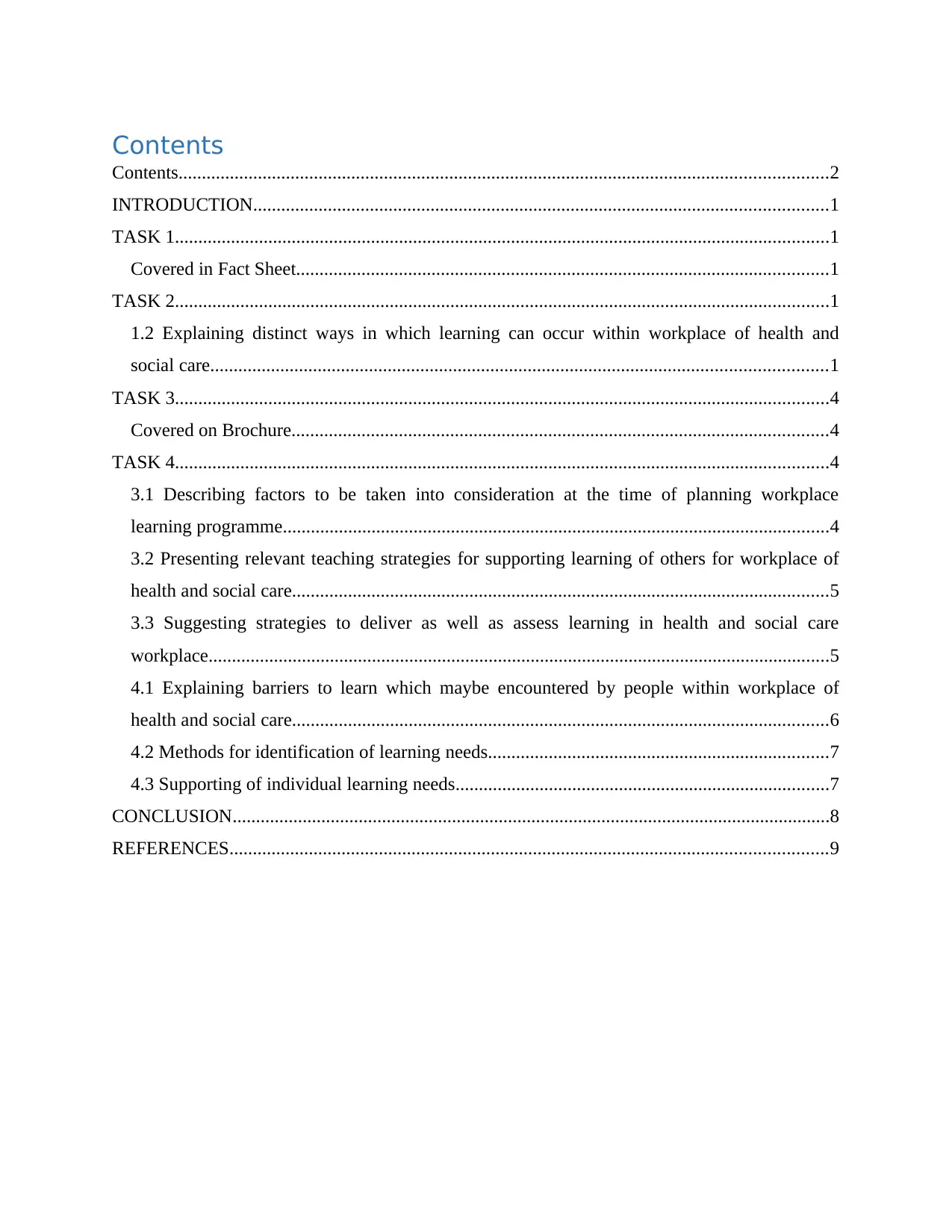
Contents
Contents...........................................................................................................................................2
INTRODUCTION...........................................................................................................................1
TASK 1............................................................................................................................................1
Covered in Fact Sheet..................................................................................................................1
TASK 2............................................................................................................................................1
1.2 Explaining distinct ways in which learning can occur within workplace of health and
social care....................................................................................................................................1
TASK 3............................................................................................................................................4
Covered on Brochure...................................................................................................................4
TASK 4............................................................................................................................................4
3.1 Describing factors to be taken into consideration at the time of planning workplace
learning programme.....................................................................................................................4
3.2 Presenting relevant teaching strategies for supporting learning of others for workplace of
health and social care...................................................................................................................5
3.3 Suggesting strategies to deliver as well as assess learning in health and social care
workplace.....................................................................................................................................5
4.1 Explaining barriers to learn which maybe encountered by people within workplace of
health and social care...................................................................................................................6
4.2 Methods for identification of learning needs.........................................................................7
4.3 Supporting of individual learning needs................................................................................7
CONCLUSION................................................................................................................................8
REFERENCES................................................................................................................................9
Contents...........................................................................................................................................2
INTRODUCTION...........................................................................................................................1
TASK 1............................................................................................................................................1
Covered in Fact Sheet..................................................................................................................1
TASK 2............................................................................................................................................1
1.2 Explaining distinct ways in which learning can occur within workplace of health and
social care....................................................................................................................................1
TASK 3............................................................................................................................................4
Covered on Brochure...................................................................................................................4
TASK 4............................................................................................................................................4
3.1 Describing factors to be taken into consideration at the time of planning workplace
learning programme.....................................................................................................................4
3.2 Presenting relevant teaching strategies for supporting learning of others for workplace of
health and social care...................................................................................................................5
3.3 Suggesting strategies to deliver as well as assess learning in health and social care
workplace.....................................................................................................................................5
4.1 Explaining barriers to learn which maybe encountered by people within workplace of
health and social care...................................................................................................................6
4.2 Methods for identification of learning needs.........................................................................7
4.3 Supporting of individual learning needs................................................................................7
CONCLUSION................................................................................................................................8
REFERENCES................................................................................................................................9
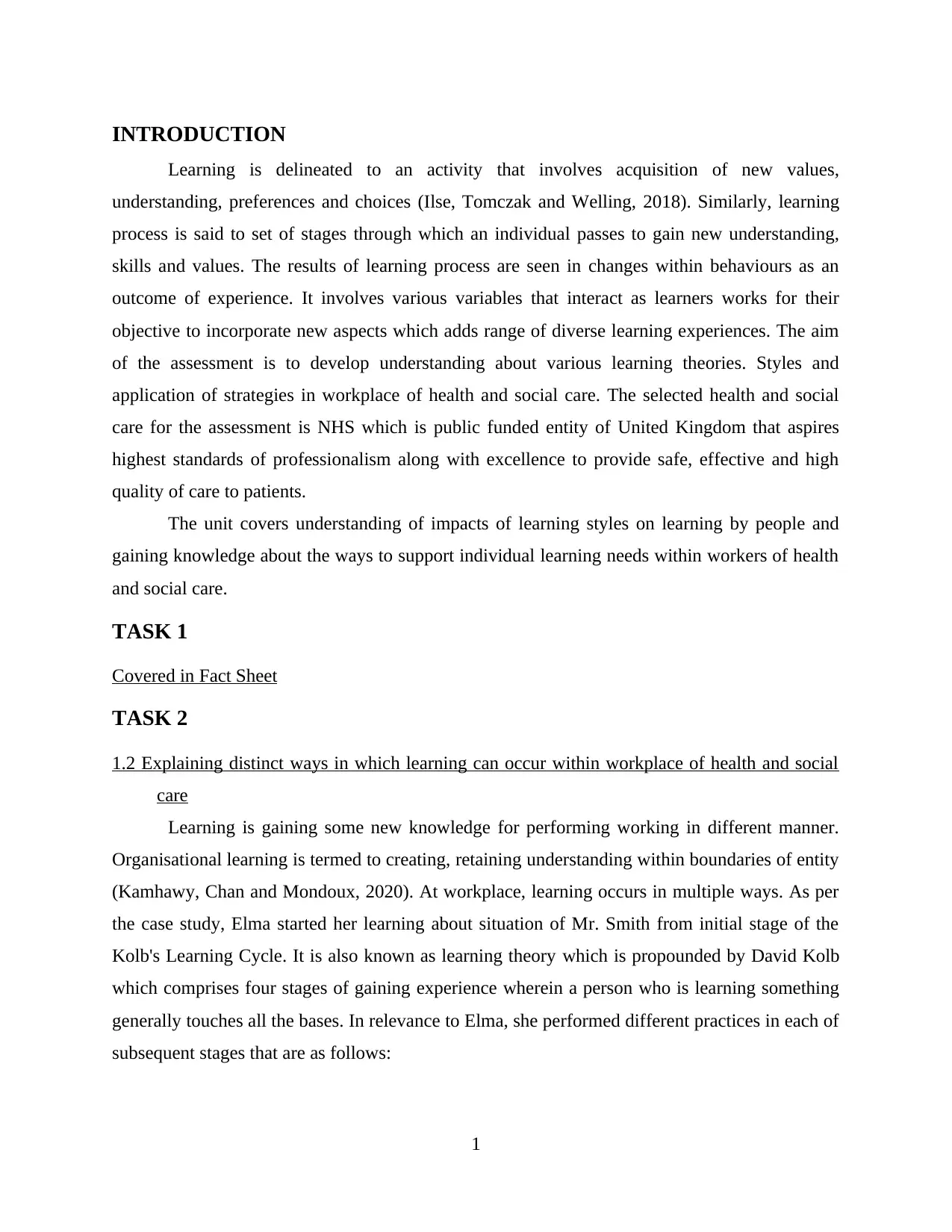
INTRODUCTION
Learning is delineated to an activity that involves acquisition of new values,
understanding, preferences and choices (Ilse, Tomczak and Welling, 2018). Similarly, learning
process is said to set of stages through which an individual passes to gain new understanding,
skills and values. The results of learning process are seen in changes within behaviours as an
outcome of experience. It involves various variables that interact as learners works for their
objective to incorporate new aspects which adds range of diverse learning experiences. The aim
of the assessment is to develop understanding about various learning theories. Styles and
application of strategies in workplace of health and social care. The selected health and social
care for the assessment is NHS which is public funded entity of United Kingdom that aspires
highest standards of professionalism along with excellence to provide safe, effective and high
quality of care to patients.
The unit covers understanding of impacts of learning styles on learning by people and
gaining knowledge about the ways to support individual learning needs within workers of health
and social care.
TASK 1
Covered in Fact Sheet
TASK 2
1.2 Explaining distinct ways in which learning can occur within workplace of health and social
care
Learning is gaining some new knowledge for performing working in different manner.
Organisational learning is termed to creating, retaining understanding within boundaries of entity
(Kamhawy, Chan and Mondoux, 2020). At workplace, learning occurs in multiple ways. As per
the case study, Elma started her learning about situation of Mr. Smith from initial stage of the
Kolb's Learning Cycle. It is also known as learning theory which is propounded by David Kolb
which comprises four stages of gaining experience wherein a person who is learning something
generally touches all the bases. In relevance to Elma, she performed different practices in each of
subsequent stages that are as follows:
1
Learning is delineated to an activity that involves acquisition of new values,
understanding, preferences and choices (Ilse, Tomczak and Welling, 2018). Similarly, learning
process is said to set of stages through which an individual passes to gain new understanding,
skills and values. The results of learning process are seen in changes within behaviours as an
outcome of experience. It involves various variables that interact as learners works for their
objective to incorporate new aspects which adds range of diverse learning experiences. The aim
of the assessment is to develop understanding about various learning theories. Styles and
application of strategies in workplace of health and social care. The selected health and social
care for the assessment is NHS which is public funded entity of United Kingdom that aspires
highest standards of professionalism along with excellence to provide safe, effective and high
quality of care to patients.
The unit covers understanding of impacts of learning styles on learning by people and
gaining knowledge about the ways to support individual learning needs within workers of health
and social care.
TASK 1
Covered in Fact Sheet
TASK 2
1.2 Explaining distinct ways in which learning can occur within workplace of health and social
care
Learning is gaining some new knowledge for performing working in different manner.
Organisational learning is termed to creating, retaining understanding within boundaries of entity
(Kamhawy, Chan and Mondoux, 2020). At workplace, learning occurs in multiple ways. As per
the case study, Elma started her learning about situation of Mr. Smith from initial stage of the
Kolb's Learning Cycle. It is also known as learning theory which is propounded by David Kolb
which comprises four stages of gaining experience wherein a person who is learning something
generally touches all the bases. In relevance to Elma, she performed different practices in each of
subsequent stages that are as follows:
1
⊘ This is a preview!⊘
Do you want full access?
Subscribe today to unlock all pages.

Trusted by 1+ million students worldwide
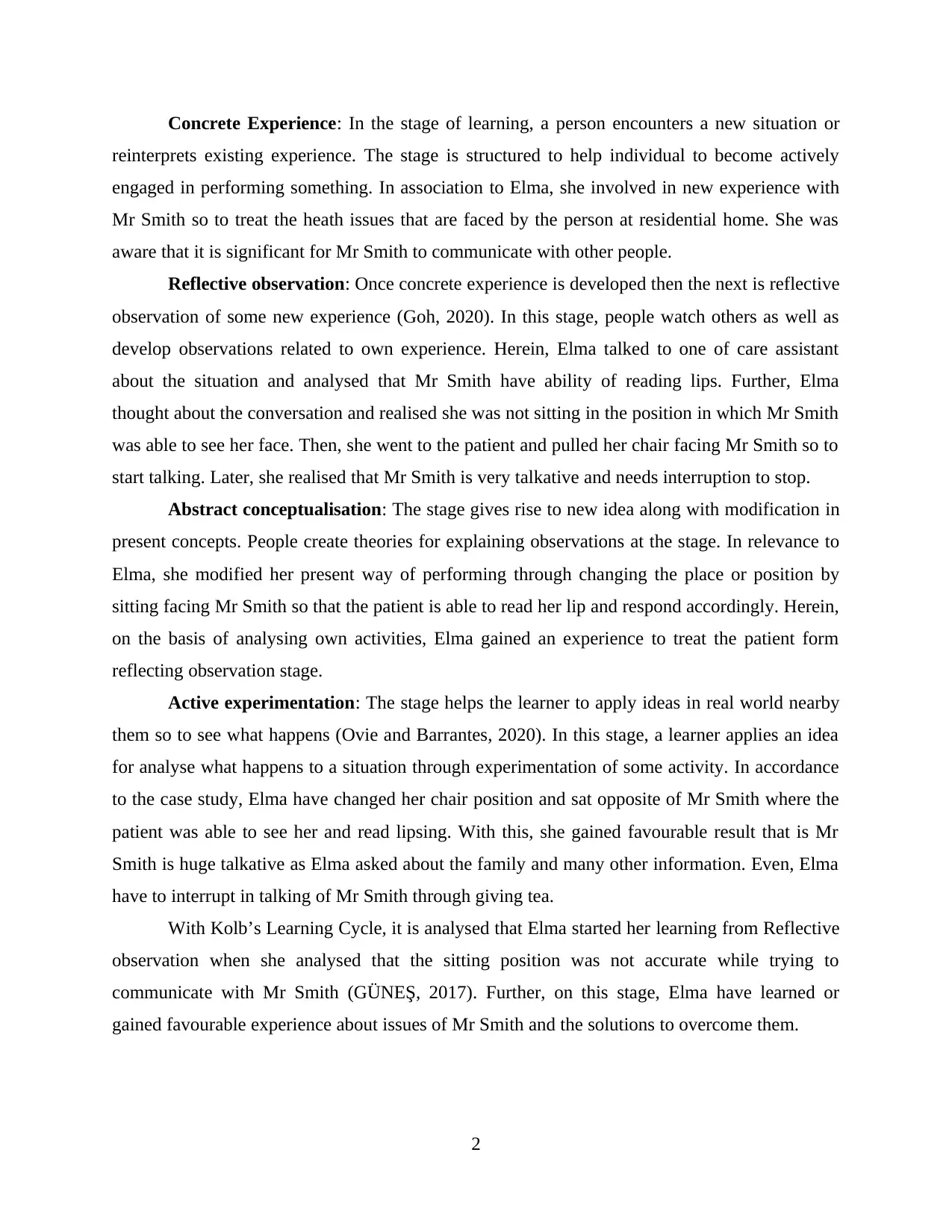
Concrete Experience: In the stage of learning, a person encounters a new situation or
reinterprets existing experience. The stage is structured to help individual to become actively
engaged in performing something. In association to Elma, she involved in new experience with
Mr Smith so to treat the heath issues that are faced by the person at residential home. She was
aware that it is significant for Mr Smith to communicate with other people.
Reflective observation: Once concrete experience is developed then the next is reflective
observation of some new experience (Goh, 2020). In this stage, people watch others as well as
develop observations related to own experience. Herein, Elma talked to one of care assistant
about the situation and analysed that Mr Smith have ability of reading lips. Further, Elma
thought about the conversation and realised she was not sitting in the position in which Mr Smith
was able to see her face. Then, she went to the patient and pulled her chair facing Mr Smith so to
start talking. Later, she realised that Mr Smith is very talkative and needs interruption to stop.
Abstract conceptualisation: The stage gives rise to new idea along with modification in
present concepts. People create theories for explaining observations at the stage. In relevance to
Elma, she modified her present way of performing through changing the place or position by
sitting facing Mr Smith so that the patient is able to read her lip and respond accordingly. Herein,
on the basis of analysing own activities, Elma gained an experience to treat the patient form
reflecting observation stage.
Active experimentation: The stage helps the learner to apply ideas in real world nearby
them so to see what happens (Ovie and Barrantes, 2020). In this stage, a learner applies an idea
for analyse what happens to a situation through experimentation of some activity. In accordance
to the case study, Elma have changed her chair position and sat opposite of Mr Smith where the
patient was able to see her and read lipsing. With this, she gained favourable result that is Mr
Smith is huge talkative as Elma asked about the family and many other information. Even, Elma
have to interrupt in talking of Mr Smith through giving tea.
With Kolb’s Learning Cycle, it is analysed that Elma started her learning from Reflective
observation when she analysed that the sitting position was not accurate while trying to
communicate with Mr Smith (GÜNEŞ, 2017). Further, on this stage, Elma have learned or
gained favourable experience about issues of Mr Smith and the solutions to overcome them.
2
reinterprets existing experience. The stage is structured to help individual to become actively
engaged in performing something. In association to Elma, she involved in new experience with
Mr Smith so to treat the heath issues that are faced by the person at residential home. She was
aware that it is significant for Mr Smith to communicate with other people.
Reflective observation: Once concrete experience is developed then the next is reflective
observation of some new experience (Goh, 2020). In this stage, people watch others as well as
develop observations related to own experience. Herein, Elma talked to one of care assistant
about the situation and analysed that Mr Smith have ability of reading lips. Further, Elma
thought about the conversation and realised she was not sitting in the position in which Mr Smith
was able to see her face. Then, she went to the patient and pulled her chair facing Mr Smith so to
start talking. Later, she realised that Mr Smith is very talkative and needs interruption to stop.
Abstract conceptualisation: The stage gives rise to new idea along with modification in
present concepts. People create theories for explaining observations at the stage. In relevance to
Elma, she modified her present way of performing through changing the place or position by
sitting facing Mr Smith so that the patient is able to read her lip and respond accordingly. Herein,
on the basis of analysing own activities, Elma gained an experience to treat the patient form
reflecting observation stage.
Active experimentation: The stage helps the learner to apply ideas in real world nearby
them so to see what happens (Ovie and Barrantes, 2020). In this stage, a learner applies an idea
for analyse what happens to a situation through experimentation of some activity. In accordance
to the case study, Elma have changed her chair position and sat opposite of Mr Smith where the
patient was able to see her and read lipsing. With this, she gained favourable result that is Mr
Smith is huge talkative as Elma asked about the family and many other information. Even, Elma
have to interrupt in talking of Mr Smith through giving tea.
With Kolb’s Learning Cycle, it is analysed that Elma started her learning from Reflective
observation when she analysed that the sitting position was not accurate while trying to
communicate with Mr Smith (GÜNEŞ, 2017). Further, on this stage, Elma have learned or
gained favourable experience about issues of Mr Smith and the solutions to overcome them.
2
Paraphrase This Document
Need a fresh take? Get an instant paraphrase of this document with our AI Paraphraser
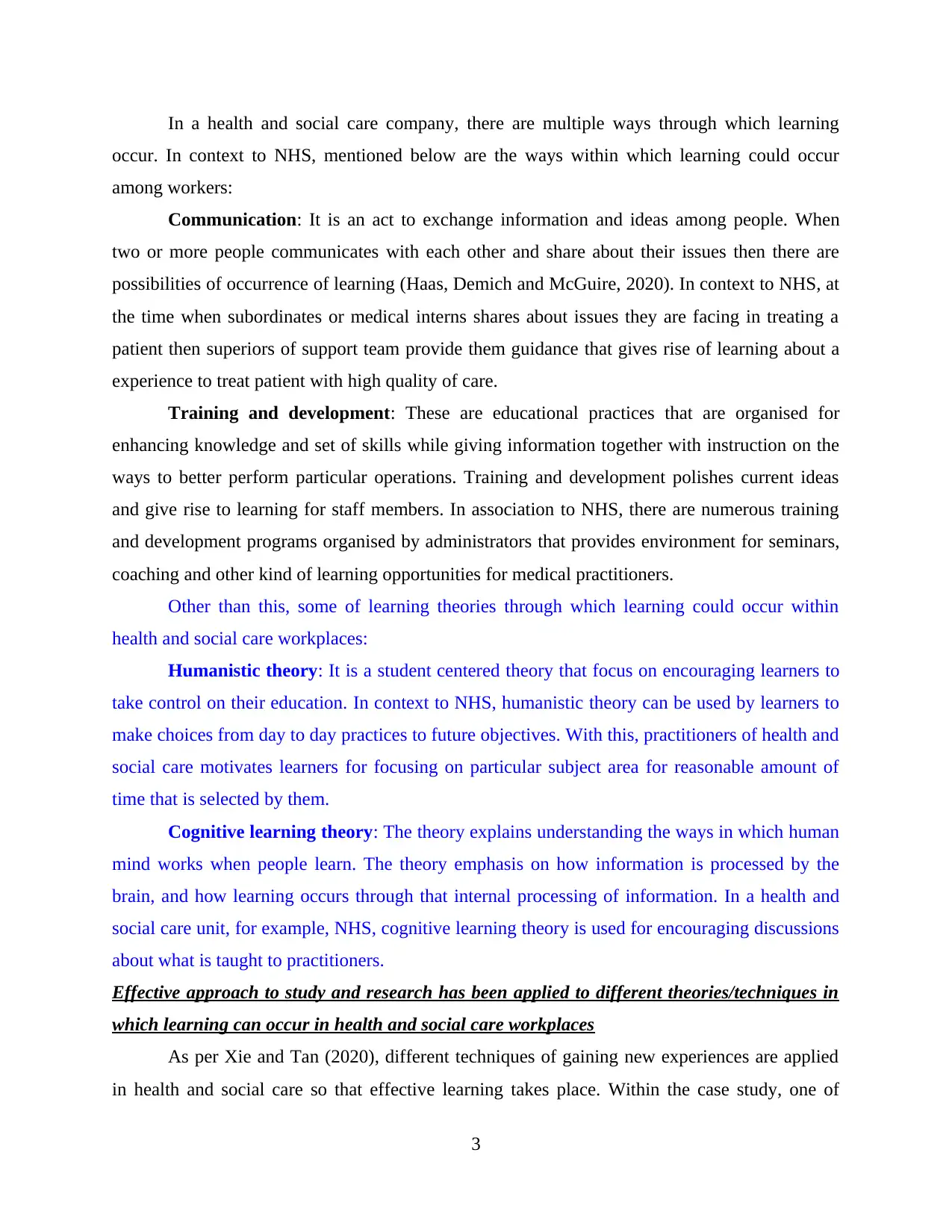
In a health and social care company, there are multiple ways through which learning
occur. In context to NHS, mentioned below are the ways within which learning could occur
among workers:
Communication: It is an act to exchange information and ideas among people. When
two or more people communicates with each other and share about their issues then there are
possibilities of occurrence of learning (Haas, Demich and McGuire, 2020). In context to NHS, at
the time when subordinates or medical interns shares about issues they are facing in treating a
patient then superiors of support team provide them guidance that gives rise of learning about a
experience to treat patient with high quality of care.
Training and development: These are educational practices that are organised for
enhancing knowledge and set of skills while giving information together with instruction on the
ways to better perform particular operations. Training and development polishes current ideas
and give rise to learning for staff members. In association to NHS, there are numerous training
and development programs organised by administrators that provides environment for seminars,
coaching and other kind of learning opportunities for medical practitioners.
Other than this, some of learning theories through which learning could occur within
health and social care workplaces:
Humanistic theory: It is a student centered theory that focus on encouraging learners to
take control on their education. In context to NHS, humanistic theory can be used by learners to
make choices from day to day practices to future objectives. With this, practitioners of health and
social care motivates learners for focusing on particular subject area for reasonable amount of
time that is selected by them.
Cognitive learning theory: The theory explains understanding the ways in which human
mind works when people learn. The theory emphasis on how information is processed by the
brain, and how learning occurs through that internal processing of information. In a health and
social care unit, for example, NHS, cognitive learning theory is used for encouraging discussions
about what is taught to practitioners.
Effective approach to study and research has been applied to different theories/techniques in
which learning can occur in health and social care workplaces
As per Xie and Tan (2020), different techniques of gaining new experiences are applied
in health and social care so that effective learning takes place. Within the case study, one of
3
occur. In context to NHS, mentioned below are the ways within which learning could occur
among workers:
Communication: It is an act to exchange information and ideas among people. When
two or more people communicates with each other and share about their issues then there are
possibilities of occurrence of learning (Haas, Demich and McGuire, 2020). In context to NHS, at
the time when subordinates or medical interns shares about issues they are facing in treating a
patient then superiors of support team provide them guidance that gives rise of learning about a
experience to treat patient with high quality of care.
Training and development: These are educational practices that are organised for
enhancing knowledge and set of skills while giving information together with instruction on the
ways to better perform particular operations. Training and development polishes current ideas
and give rise to learning for staff members. In association to NHS, there are numerous training
and development programs organised by administrators that provides environment for seminars,
coaching and other kind of learning opportunities for medical practitioners.
Other than this, some of learning theories through which learning could occur within
health and social care workplaces:
Humanistic theory: It is a student centered theory that focus on encouraging learners to
take control on their education. In context to NHS, humanistic theory can be used by learners to
make choices from day to day practices to future objectives. With this, practitioners of health and
social care motivates learners for focusing on particular subject area for reasonable amount of
time that is selected by them.
Cognitive learning theory: The theory explains understanding the ways in which human
mind works when people learn. The theory emphasis on how information is processed by the
brain, and how learning occurs through that internal processing of information. In a health and
social care unit, for example, NHS, cognitive learning theory is used for encouraging discussions
about what is taught to practitioners.
Effective approach to study and research has been applied to different theories/techniques in
which learning can occur in health and social care workplaces
As per Xie and Tan (2020), different techniques of gaining new experiences are applied
in health and social care so that effective learning takes place. Within the case study, one of
3
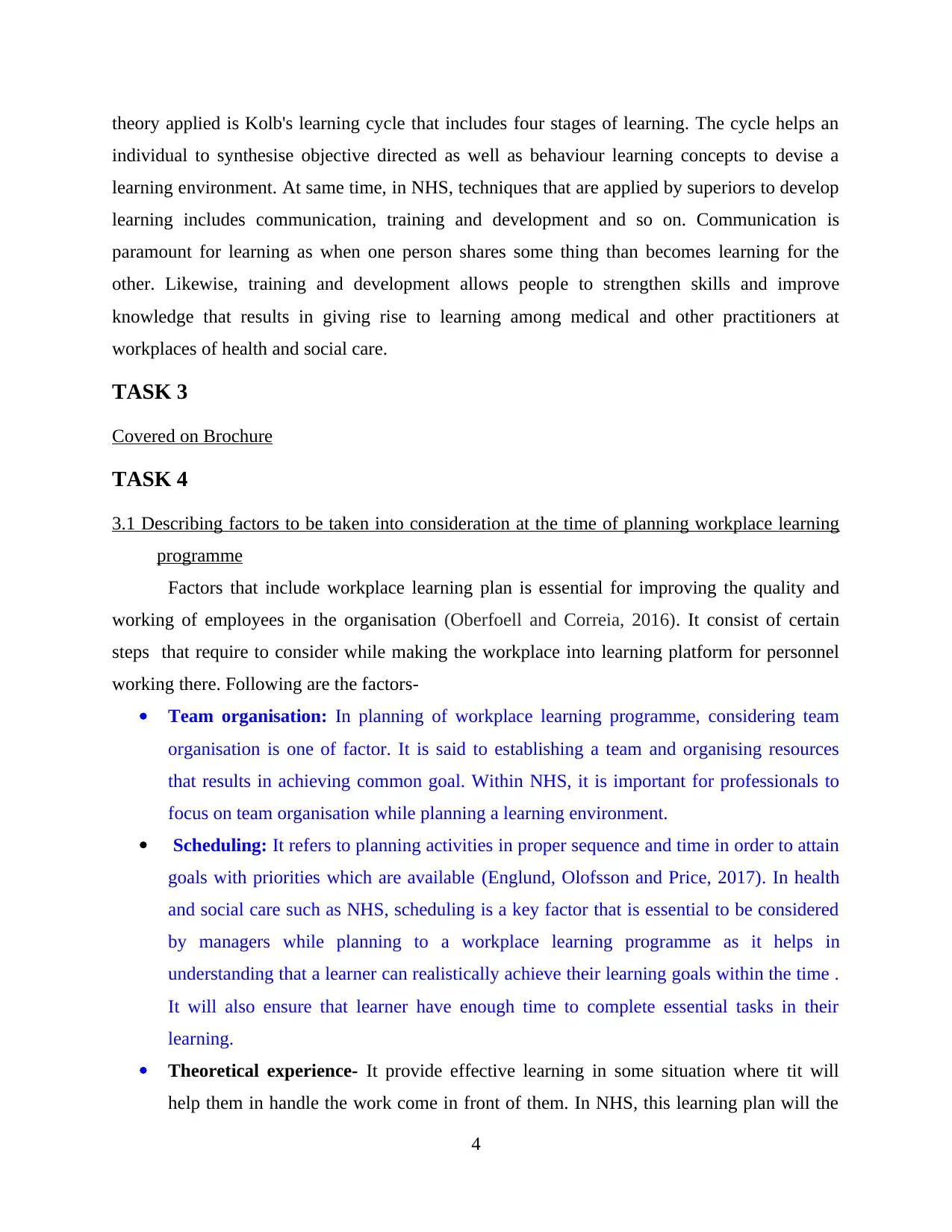
theory applied is Kolb's learning cycle that includes four stages of learning. The cycle helps an
individual to synthesise objective directed as well as behaviour learning concepts to devise a
learning environment. At same time, in NHS, techniques that are applied by superiors to develop
learning includes communication, training and development and so on. Communication is
paramount for learning as when one person shares some thing than becomes learning for the
other. Likewise, training and development allows people to strengthen skills and improve
knowledge that results in giving rise to learning among medical and other practitioners at
workplaces of health and social care.
TASK 3
Covered on Brochure
TASK 4
3.1 Describing factors to be taken into consideration at the time of planning workplace learning
programme
Factors that include workplace learning plan is essential for improving the quality and
working of employees in the organisation (Oberfoell and Correia, 2016). It consist of certain
steps that require to consider while making the workplace into learning platform for personnel
working there. Following are the factors-
Team organisation: In planning of workplace learning programme, considering team
organisation is one of factor. It is said to establishing a team and organising resources
that results in achieving common goal. Within NHS, it is important for professionals to
focus on team organisation while planning a learning environment.
Scheduling: It refers to planning activities in proper sequence and time in order to attain
goals with priorities which are available (Englund, Olofsson and Price, 2017). In health
and social care such as NHS, scheduling is a key factor that is essential to be considered
by managers while planning to a workplace learning programme as it helps in
understanding that a learner can realistically achieve their learning goals within the time .
It will also ensure that learner have enough time to complete essential tasks in their
learning.
Theoretical experience- It provide effective learning in some situation where tit will
help them in handle the work come in front of them. In NHS, this learning plan will the
4
individual to synthesise objective directed as well as behaviour learning concepts to devise a
learning environment. At same time, in NHS, techniques that are applied by superiors to develop
learning includes communication, training and development and so on. Communication is
paramount for learning as when one person shares some thing than becomes learning for the
other. Likewise, training and development allows people to strengthen skills and improve
knowledge that results in giving rise to learning among medical and other practitioners at
workplaces of health and social care.
TASK 3
Covered on Brochure
TASK 4
3.1 Describing factors to be taken into consideration at the time of planning workplace learning
programme
Factors that include workplace learning plan is essential for improving the quality and
working of employees in the organisation (Oberfoell and Correia, 2016). It consist of certain
steps that require to consider while making the workplace into learning platform for personnel
working there. Following are the factors-
Team organisation: In planning of workplace learning programme, considering team
organisation is one of factor. It is said to establishing a team and organising resources
that results in achieving common goal. Within NHS, it is important for professionals to
focus on team organisation while planning a learning environment.
Scheduling: It refers to planning activities in proper sequence and time in order to attain
goals with priorities which are available (Englund, Olofsson and Price, 2017). In health
and social care such as NHS, scheduling is a key factor that is essential to be considered
by managers while planning to a workplace learning programme as it helps in
understanding that a learner can realistically achieve their learning goals within the time .
It will also ensure that learner have enough time to complete essential tasks in their
learning.
Theoretical experience- It provide effective learning in some situation where tit will
help them in handle the work come in front of them. In NHS, this learning plan will the
4
⊘ This is a preview!⊘
Do you want full access?
Subscribe today to unlock all pages.

Trusted by 1+ million students worldwide
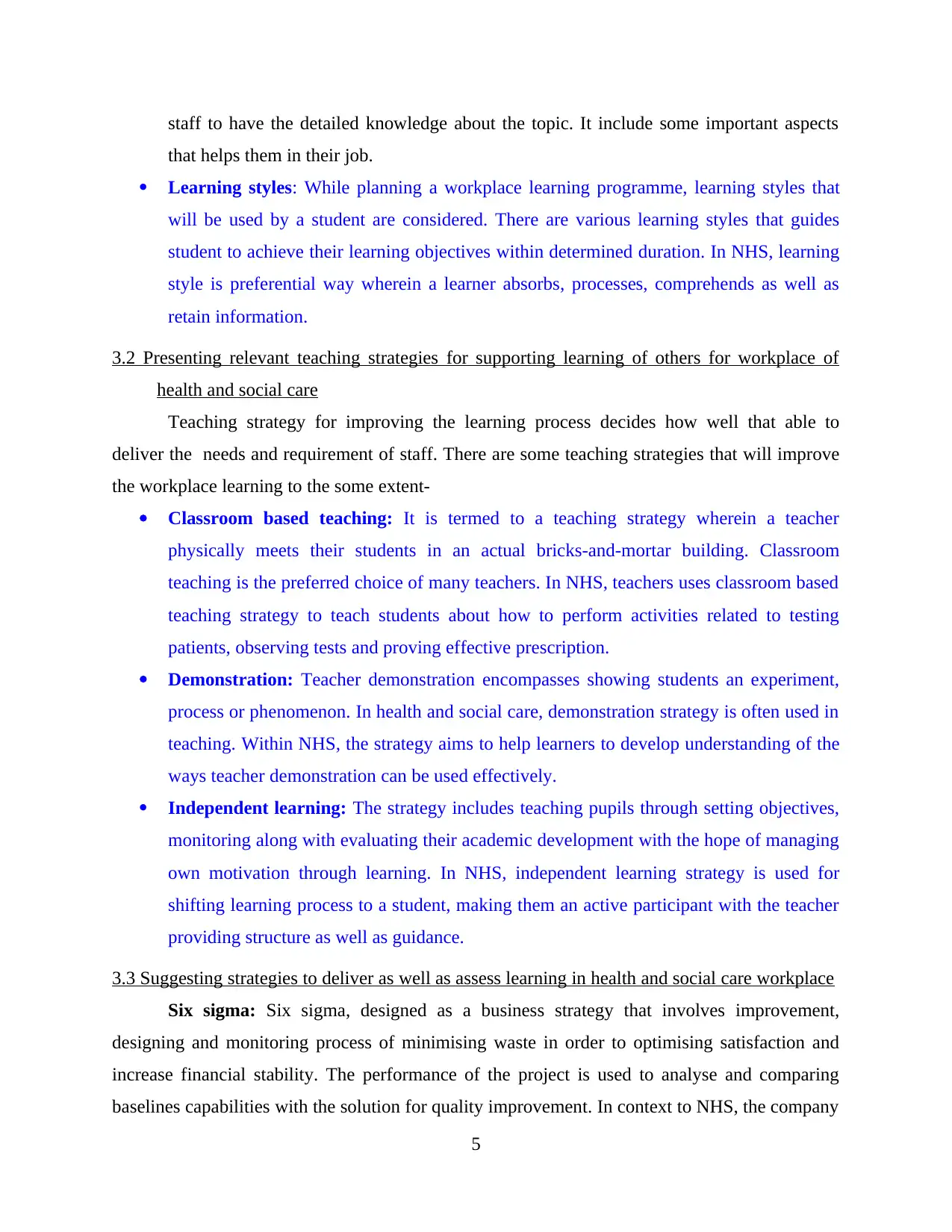
staff to have the detailed knowledge about the topic. It include some important aspects
that helps them in their job.
Learning styles: While planning a workplace learning programme, learning styles that
will be used by a student are considered. There are various learning styles that guides
student to achieve their learning objectives within determined duration. In NHS, learning
style is preferential way wherein a learner absorbs, processes, comprehends as well as
retain information.
3.2 Presenting relevant teaching strategies for supporting learning of others for workplace of
health and social care
Teaching strategy for improving the learning process decides how well that able to
deliver the needs and requirement of staff. There are some teaching strategies that will improve
the workplace learning to the some extent-
Classroom based teaching: It is termed to a teaching strategy wherein a teacher
physically meets their students in an actual bricks-and-mortar building. Classroom
teaching is the preferred choice of many teachers. In NHS, teachers uses classroom based
teaching strategy to teach students about how to perform activities related to testing
patients, observing tests and proving effective prescription.
Demonstration: Teacher demonstration encompasses showing students an experiment,
process or phenomenon. In health and social care, demonstration strategy is often used in
teaching. Within NHS, the strategy aims to help learners to develop understanding of the
ways teacher demonstration can be used effectively.
Independent learning: The strategy includes teaching pupils through setting objectives,
monitoring along with evaluating their academic development with the hope of managing
own motivation through learning. In NHS, independent learning strategy is used for
shifting learning process to a student, making them an active participant with the teacher
providing structure as well as guidance.
3.3 Suggesting strategies to deliver as well as assess learning in health and social care workplace
Six sigma: Six sigma, designed as a business strategy that involves improvement,
designing and monitoring process of minimising waste in order to optimising satisfaction and
increase financial stability. The performance of the project is used to analyse and comparing
baselines capabilities with the solution for quality improvement. In context to NHS, the company
5
that helps them in their job.
Learning styles: While planning a workplace learning programme, learning styles that
will be used by a student are considered. There are various learning styles that guides
student to achieve their learning objectives within determined duration. In NHS, learning
style is preferential way wherein a learner absorbs, processes, comprehends as well as
retain information.
3.2 Presenting relevant teaching strategies for supporting learning of others for workplace of
health and social care
Teaching strategy for improving the learning process decides how well that able to
deliver the needs and requirement of staff. There are some teaching strategies that will improve
the workplace learning to the some extent-
Classroom based teaching: It is termed to a teaching strategy wherein a teacher
physically meets their students in an actual bricks-and-mortar building. Classroom
teaching is the preferred choice of many teachers. In NHS, teachers uses classroom based
teaching strategy to teach students about how to perform activities related to testing
patients, observing tests and proving effective prescription.
Demonstration: Teacher demonstration encompasses showing students an experiment,
process or phenomenon. In health and social care, demonstration strategy is often used in
teaching. Within NHS, the strategy aims to help learners to develop understanding of the
ways teacher demonstration can be used effectively.
Independent learning: The strategy includes teaching pupils through setting objectives,
monitoring along with evaluating their academic development with the hope of managing
own motivation through learning. In NHS, independent learning strategy is used for
shifting learning process to a student, making them an active participant with the teacher
providing structure as well as guidance.
3.3 Suggesting strategies to deliver as well as assess learning in health and social care workplace
Six sigma: Six sigma, designed as a business strategy that involves improvement,
designing and monitoring process of minimising waste in order to optimising satisfaction and
increase financial stability. The performance of the project is used to analyse and comparing
baselines capabilities with the solution for quality improvement. In context to NHS, the company
5
Paraphrase This Document
Need a fresh take? Get an instant paraphrase of this document with our AI Paraphraser
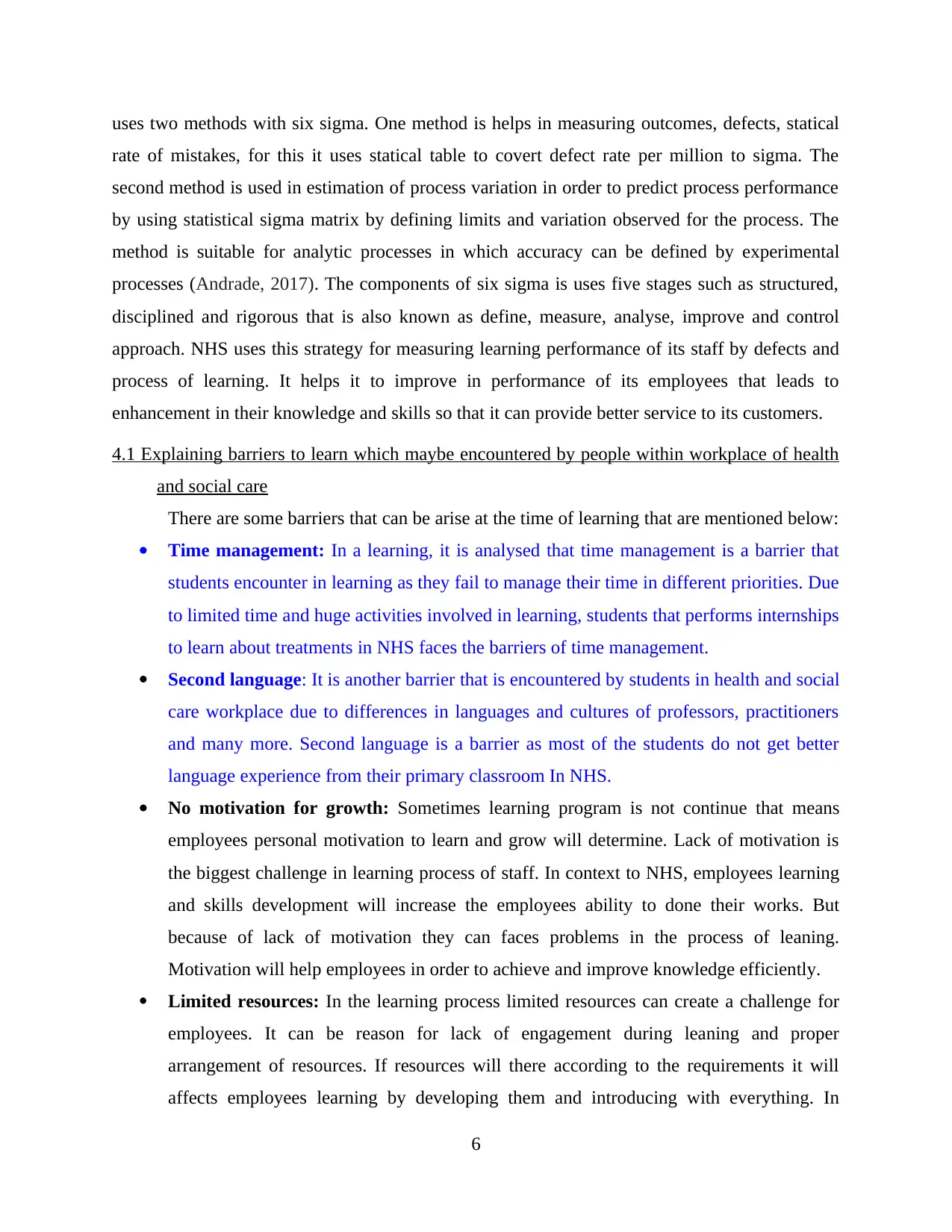
uses two methods with six sigma. One method is helps in measuring outcomes, defects, statical
rate of mistakes, for this it uses statical table to covert defect rate per million to sigma. The
second method is used in estimation of process variation in order to predict process performance
by using statistical sigma matrix by defining limits and variation observed for the process. The
method is suitable for analytic processes in which accuracy can be defined by experimental
processes (Andrade, 2017). The components of six sigma is uses five stages such as structured,
disciplined and rigorous that is also known as define, measure, analyse, improve and control
approach. NHS uses this strategy for measuring learning performance of its staff by defects and
process of learning. It helps it to improve in performance of its employees that leads to
enhancement in their knowledge and skills so that it can provide better service to its customers.
4.1 Explaining barriers to learn which maybe encountered by people within workplace of health
and social care
There are some barriers that can be arise at the time of learning that are mentioned below:
Time management: In a learning, it is analysed that time management is a barrier that
students encounter in learning as they fail to manage their time in different priorities. Due
to limited time and huge activities involved in learning, students that performs internships
to learn about treatments in NHS faces the barriers of time management.
Second language: It is another barrier that is encountered by students in health and social
care workplace due to differences in languages and cultures of professors, practitioners
and many more. Second language is a barrier as most of the students do not get better
language experience from their primary classroom In NHS.
No motivation for growth: Sometimes learning program is not continue that means
employees personal motivation to learn and grow will determine. Lack of motivation is
the biggest challenge in learning process of staff. In context to NHS, employees learning
and skills development will increase the employees ability to done their works. But
because of lack of motivation they can faces problems in the process of leaning.
Motivation will help employees in order to achieve and improve knowledge efficiently.
Limited resources: In the learning process limited resources can create a challenge for
employees. It can be reason for lack of engagement during leaning and proper
arrangement of resources. If resources will there according to the requirements it will
affects employees learning by developing them and introducing with everything. In
6
rate of mistakes, for this it uses statical table to covert defect rate per million to sigma. The
second method is used in estimation of process variation in order to predict process performance
by using statistical sigma matrix by defining limits and variation observed for the process. The
method is suitable for analytic processes in which accuracy can be defined by experimental
processes (Andrade, 2017). The components of six sigma is uses five stages such as structured,
disciplined and rigorous that is also known as define, measure, analyse, improve and control
approach. NHS uses this strategy for measuring learning performance of its staff by defects and
process of learning. It helps it to improve in performance of its employees that leads to
enhancement in their knowledge and skills so that it can provide better service to its customers.
4.1 Explaining barriers to learn which maybe encountered by people within workplace of health
and social care
There are some barriers that can be arise at the time of learning that are mentioned below:
Time management: In a learning, it is analysed that time management is a barrier that
students encounter in learning as they fail to manage their time in different priorities. Due
to limited time and huge activities involved in learning, students that performs internships
to learn about treatments in NHS faces the barriers of time management.
Second language: It is another barrier that is encountered by students in health and social
care workplace due to differences in languages and cultures of professors, practitioners
and many more. Second language is a barrier as most of the students do not get better
language experience from their primary classroom In NHS.
No motivation for growth: Sometimes learning program is not continue that means
employees personal motivation to learn and grow will determine. Lack of motivation is
the biggest challenge in learning process of staff. In context to NHS, employees learning
and skills development will increase the employees ability to done their works. But
because of lack of motivation they can faces problems in the process of leaning.
Motivation will help employees in order to achieve and improve knowledge efficiently.
Limited resources: In the learning process limited resources can create a challenge for
employees. It can be reason for lack of engagement during leaning and proper
arrangement of resources. If resources will there according to the requirements it will
affects employees learning by developing them and introducing with everything. In
6
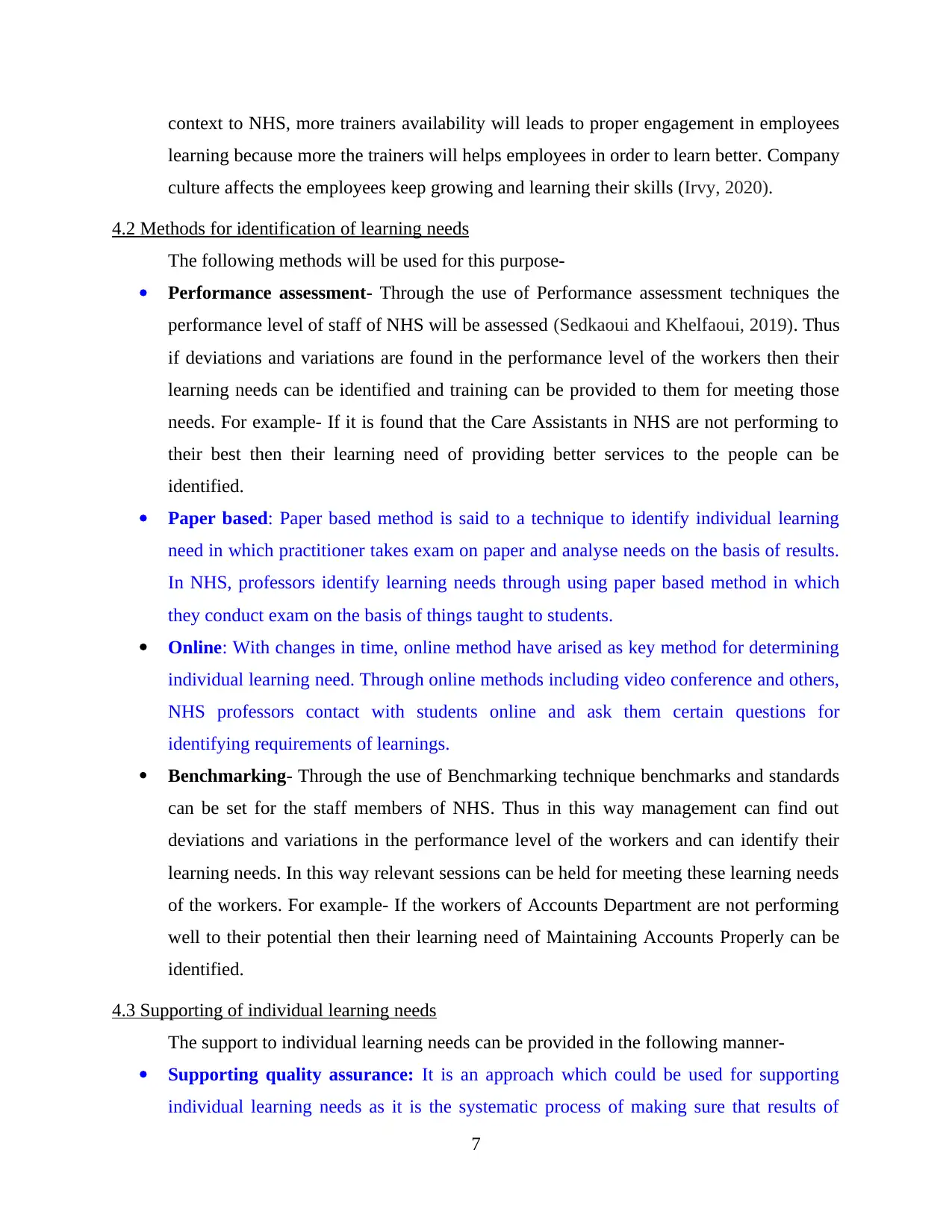
context to NHS, more trainers availability will leads to proper engagement in employees
learning because more the trainers will helps employees in order to learn better. Company
culture affects the employees keep growing and learning their skills (Irvy, 2020).
4.2 Methods for identification of learning needs
The following methods will be used for this purpose-
Performance assessment- Through the use of Performance assessment techniques the
performance level of staff of NHS will be assessed (Sedkaoui and Khelfaoui, 2019). Thus
if deviations and variations are found in the performance level of the workers then their
learning needs can be identified and training can be provided to them for meeting those
needs. For example- If it is found that the Care Assistants in NHS are not performing to
their best then their learning need of providing better services to the people can be
identified.
Paper based: Paper based method is said to a technique to identify individual learning
need in which practitioner takes exam on paper and analyse needs on the basis of results.
In NHS, professors identify learning needs through using paper based method in which
they conduct exam on the basis of things taught to students.
Online: With changes in time, online method have arised as key method for determining
individual learning need. Through online methods including video conference and others,
NHS professors contact with students online and ask them certain questions for
identifying requirements of learnings.
Benchmarking- Through the use of Benchmarking technique benchmarks and standards
can be set for the staff members of NHS. Thus in this way management can find out
deviations and variations in the performance level of the workers and can identify their
learning needs. In this way relevant sessions can be held for meeting these learning needs
of the workers. For example- If the workers of Accounts Department are not performing
well to their potential then their learning need of Maintaining Accounts Properly can be
identified.
4.3 Supporting of individual learning needs
The support to individual learning needs can be provided in the following manner-
Supporting quality assurance: It is an approach which could be used for supporting
individual learning needs as it is the systematic process of making sure that results of
7
learning because more the trainers will helps employees in order to learn better. Company
culture affects the employees keep growing and learning their skills (Irvy, 2020).
4.2 Methods for identification of learning needs
The following methods will be used for this purpose-
Performance assessment- Through the use of Performance assessment techniques the
performance level of staff of NHS will be assessed (Sedkaoui and Khelfaoui, 2019). Thus
if deviations and variations are found in the performance level of the workers then their
learning needs can be identified and training can be provided to them for meeting those
needs. For example- If it is found that the Care Assistants in NHS are not performing to
their best then their learning need of providing better services to the people can be
identified.
Paper based: Paper based method is said to a technique to identify individual learning
need in which practitioner takes exam on paper and analyse needs on the basis of results.
In NHS, professors identify learning needs through using paper based method in which
they conduct exam on the basis of things taught to students.
Online: With changes in time, online method have arised as key method for determining
individual learning need. Through online methods including video conference and others,
NHS professors contact with students online and ask them certain questions for
identifying requirements of learnings.
Benchmarking- Through the use of Benchmarking technique benchmarks and standards
can be set for the staff members of NHS. Thus in this way management can find out
deviations and variations in the performance level of the workers and can identify their
learning needs. In this way relevant sessions can be held for meeting these learning needs
of the workers. For example- If the workers of Accounts Department are not performing
well to their potential then their learning need of Maintaining Accounts Properly can be
identified.
4.3 Supporting of individual learning needs
The support to individual learning needs can be provided in the following manner-
Supporting quality assurance: It is an approach which could be used for supporting
individual learning needs as it is the systematic process of making sure that results of
7
⊘ This is a preview!⊘
Do you want full access?
Subscribe today to unlock all pages.

Trusted by 1+ million students worldwide
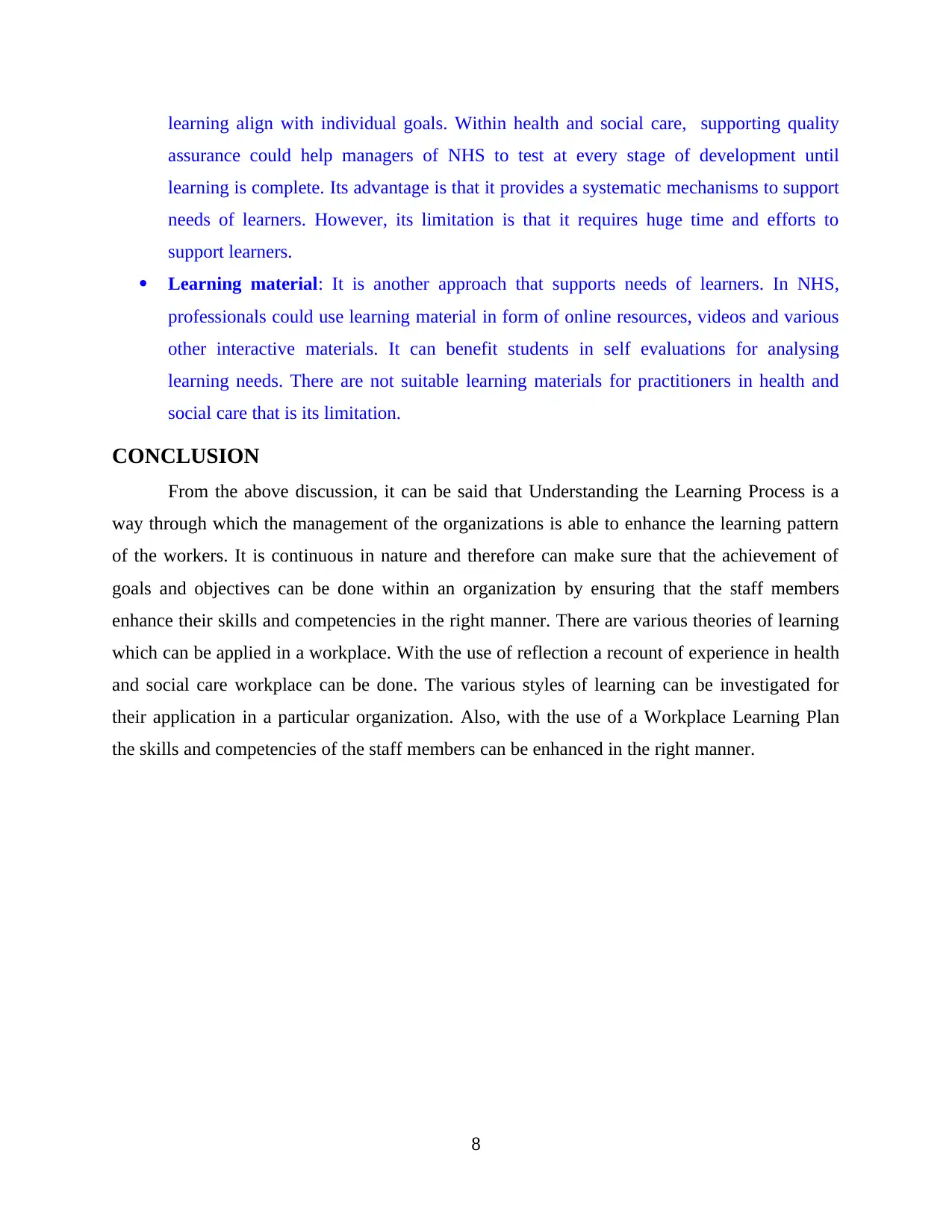
learning align with individual goals. Within health and social care, supporting quality
assurance could help managers of NHS to test at every stage of development until
learning is complete. Its advantage is that it provides a systematic mechanisms to support
needs of learners. However, its limitation is that it requires huge time and efforts to
support learners.
Learning material: It is another approach that supports needs of learners. In NHS,
professionals could use learning material in form of online resources, videos and various
other interactive materials. It can benefit students in self evaluations for analysing
learning needs. There are not suitable learning materials for practitioners in health and
social care that is its limitation.
CONCLUSION
From the above discussion, it can be said that Understanding the Learning Process is a
way through which the management of the organizations is able to enhance the learning pattern
of the workers. It is continuous in nature and therefore can make sure that the achievement of
goals and objectives can be done within an organization by ensuring that the staff members
enhance their skills and competencies in the right manner. There are various theories of learning
which can be applied in a workplace. With the use of reflection a recount of experience in health
and social care workplace can be done. The various styles of learning can be investigated for
their application in a particular organization. Also, with the use of a Workplace Learning Plan
the skills and competencies of the staff members can be enhanced in the right manner.
8
assurance could help managers of NHS to test at every stage of development until
learning is complete. Its advantage is that it provides a systematic mechanisms to support
needs of learners. However, its limitation is that it requires huge time and efforts to
support learners.
Learning material: It is another approach that supports needs of learners. In NHS,
professionals could use learning material in form of online resources, videos and various
other interactive materials. It can benefit students in self evaluations for analysing
learning needs. There are not suitable learning materials for practitioners in health and
social care that is its limitation.
CONCLUSION
From the above discussion, it can be said that Understanding the Learning Process is a
way through which the management of the organizations is able to enhance the learning pattern
of the workers. It is continuous in nature and therefore can make sure that the achievement of
goals and objectives can be done within an organization by ensuring that the staff members
enhance their skills and competencies in the right manner. There are various theories of learning
which can be applied in a workplace. With the use of reflection a recount of experience in health
and social care workplace can be done. The various styles of learning can be investigated for
their application in a particular organization. Also, with the use of a Workplace Learning Plan
the skills and competencies of the staff members can be enhanced in the right manner.
8
Paraphrase This Document
Need a fresh take? Get an instant paraphrase of this document with our AI Paraphraser
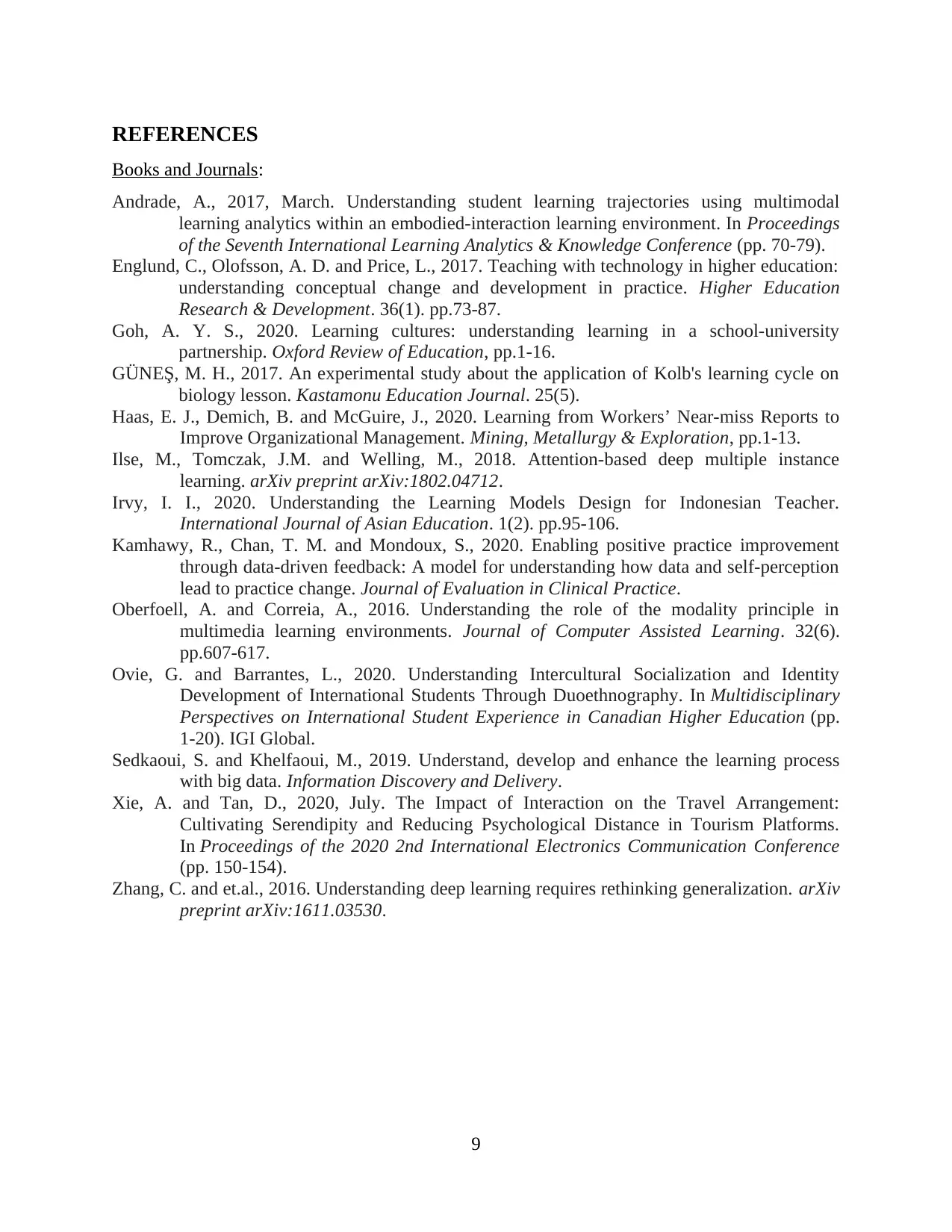
REFERENCES
Books and Journals:
Andrade, A., 2017, March. Understanding student learning trajectories using multimodal
learning analytics within an embodied-interaction learning environment. In Proceedings
of the Seventh International Learning Analytics & Knowledge Conference (pp. 70-79).
Englund, C., Olofsson, A. D. and Price, L., 2017. Teaching with technology in higher education:
understanding conceptual change and development in practice. Higher Education
Research & Development. 36(1). pp.73-87.
Goh, A. Y. S., 2020. Learning cultures: understanding learning in a school-university
partnership. Oxford Review of Education, pp.1-16.
GÜNEŞ, M. H., 2017. An experimental study about the application of Kolb's learning cycle on
biology lesson. Kastamonu Education Journal. 25(5).
Haas, E. J., Demich, B. and McGuire, J., 2020. Learning from Workers’ Near-miss Reports to
Improve Organizational Management. Mining, Metallurgy & Exploration, pp.1-13.
Ilse, M., Tomczak, J.M. and Welling, M., 2018. Attention-based deep multiple instance
learning. arXiv preprint arXiv:1802.04712.
Irvy, I. I., 2020. Understanding the Learning Models Design for Indonesian Teacher.
International Journal of Asian Education. 1(2). pp.95-106.
Kamhawy, R., Chan, T. M. and Mondoux, S., 2020. Enabling positive practice improvement
through data‐driven feedback: A model for understanding how data and self‐perception
lead to practice change. Journal of Evaluation in Clinical Practice.
Oberfoell, A. and Correia, A., 2016. Understanding the role of the modality principle in
multimedia learning environments. Journal of Computer Assisted Learning. 32(6).
pp.607-617.
Ovie, G. and Barrantes, L., 2020. Understanding Intercultural Socialization and Identity
Development of International Students Through Duoethnography. In Multidisciplinary
Perspectives on International Student Experience in Canadian Higher Education (pp.
1-20). IGI Global.
Sedkaoui, S. and Khelfaoui, M., 2019. Understand, develop and enhance the learning process
with big data. Information Discovery and Delivery.
Xie, A. and Tan, D., 2020, July. The Impact of Interaction on the Travel Arrangement:
Cultivating Serendipity and Reducing Psychological Distance in Tourism Platforms.
In Proceedings of the 2020 2nd International Electronics Communication Conference
(pp. 150-154).
Zhang, C. and et.al., 2016. Understanding deep learning requires rethinking generalization. arXiv
preprint arXiv:1611.03530.
9
Books and Journals:
Andrade, A., 2017, March. Understanding student learning trajectories using multimodal
learning analytics within an embodied-interaction learning environment. In Proceedings
of the Seventh International Learning Analytics & Knowledge Conference (pp. 70-79).
Englund, C., Olofsson, A. D. and Price, L., 2017. Teaching with technology in higher education:
understanding conceptual change and development in practice. Higher Education
Research & Development. 36(1). pp.73-87.
Goh, A. Y. S., 2020. Learning cultures: understanding learning in a school-university
partnership. Oxford Review of Education, pp.1-16.
GÜNEŞ, M. H., 2017. An experimental study about the application of Kolb's learning cycle on
biology lesson. Kastamonu Education Journal. 25(5).
Haas, E. J., Demich, B. and McGuire, J., 2020. Learning from Workers’ Near-miss Reports to
Improve Organizational Management. Mining, Metallurgy & Exploration, pp.1-13.
Ilse, M., Tomczak, J.M. and Welling, M., 2018. Attention-based deep multiple instance
learning. arXiv preprint arXiv:1802.04712.
Irvy, I. I., 2020. Understanding the Learning Models Design for Indonesian Teacher.
International Journal of Asian Education. 1(2). pp.95-106.
Kamhawy, R., Chan, T. M. and Mondoux, S., 2020. Enabling positive practice improvement
through data‐driven feedback: A model for understanding how data and self‐perception
lead to practice change. Journal of Evaluation in Clinical Practice.
Oberfoell, A. and Correia, A., 2016. Understanding the role of the modality principle in
multimedia learning environments. Journal of Computer Assisted Learning. 32(6).
pp.607-617.
Ovie, G. and Barrantes, L., 2020. Understanding Intercultural Socialization and Identity
Development of International Students Through Duoethnography. In Multidisciplinary
Perspectives on International Student Experience in Canadian Higher Education (pp.
1-20). IGI Global.
Sedkaoui, S. and Khelfaoui, M., 2019. Understand, develop and enhance the learning process
with big data. Information Discovery and Delivery.
Xie, A. and Tan, D., 2020, July. The Impact of Interaction on the Travel Arrangement:
Cultivating Serendipity and Reducing Psychological Distance in Tourism Platforms.
In Proceedings of the 2020 2nd International Electronics Communication Conference
(pp. 150-154).
Zhang, C. and et.al., 2016. Understanding deep learning requires rethinking generalization. arXiv
preprint arXiv:1611.03530.
9
1 out of 11
Related Documents
Your All-in-One AI-Powered Toolkit for Academic Success.
+13062052269
info@desklib.com
Available 24*7 on WhatsApp / Email
![[object Object]](/_next/static/media/star-bottom.7253800d.svg)
Unlock your academic potential
Copyright © 2020–2025 A2Z Services. All Rights Reserved. Developed and managed by ZUCOL.




